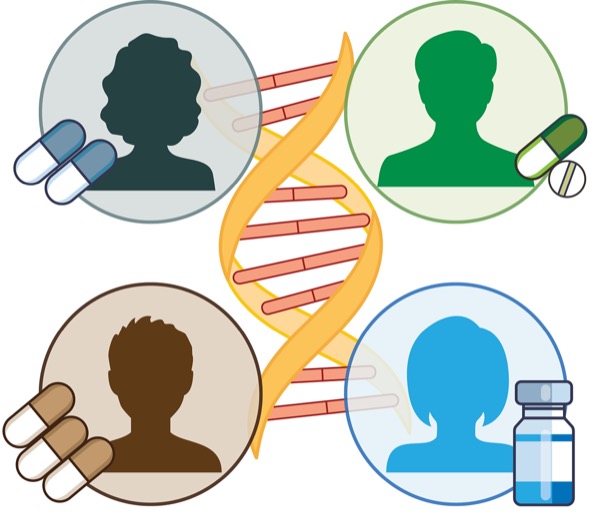The burgeoning field of pharmacogenomics (PGx) can inform chemotherapy dosing and supportive care in oncology, and pharmacists have a key role to play in these efforts.
“Pharmacists [are] the experts in pharmacology and drug prescribing, so it’s imperative they feel comfortable understanding and applying PGx results in practice,” Jai N. Patel, PharmD, BCOP, CPP, the chair of the Department of Cancer Pharmacology and Pharmacogenomics at Atrium Health’s Levine Cancer Institute, in Charlotte, N.C., told Pharmacy Practice News.
PGx (also known as pharmacogenetics) focuses on how a person’s genotype affects drug response. (Somatic mutations and tumor profiling are generally considered a separate subset of precision medicine, Dr. Patel said.) Oncology and mental health are two specialties in which PGx is being adopted particularly quickly.
Within oncology, PGx offers two primary advantages. The first is the ability to administer more precise chemotherapy doses, which improves patient safety and possibly enhances tolerability, Dr. Patel said. “The second is the ability to tailor supportive care therapies, like pain medications and antidepressants.”
However, he noted that PGx faces several implementation challenges. “Unfortunately, there is still a lot of variability in reimbursement for these tests, which limits their [broad] application. Further, clinicians must be aware that these tests exist and the implications of testing, but unfortunately, most clinical practice guidelines within oncology do not yet recommend pretreatment PGx testing.”
PGx in Action
Researchers have identified gene–drug interactions relevant to a wide variety of oncology indications, such as lymphoma, leukemia, neuroblastoma, and gastrointestinal, breast, urothelial, cervical, lung and ovarian cancers (CA Cancer J Clin 2022;72[4]:315-332). In most cases, the clinical implication of these gene variants is an increased risk for drug-related toxicities, Dr. Patel said during a presentation at the HOPA Annual Conference 2023, in Phoenix.
One gene with particular significance in oncology is DPYD, which codes for dihydropyrimidine dehydrogenase (DPD) (Lancet Oncol 2015;16[16]:1639-1650). This enzyme helps metabolize fluoropyrimidines used to treat breast, colorectal, pancreatic, esophageal, and head and neck cancers. Genetic variations in DPYD can result in DPD deficiency, which interferes with the breakdown of uracil and thymine, and renders carriers more vulnerable to severe and potentially fatal side effects from drugs such as 5-fluorouracil (5-FU) and capecitabine. A 2021 meta-analysis of patients who received standard-dose fluoropyrimidine chemotherapy revealed that carriers of a pathogenic DPYD variant had a 25.6-fold increased risk for treatment-related death, with an absolute mortality risk of up to 3.7% (Oncologist 2021;26[12]:1008-1016).
“Our findings give additional support for the use of DPYD genotyping as an effective tool for identifying patients at risk for fatal toxicity from fluoropyrimidine chemotherapy,” the authors wrote.
Other studies have demonstrated that tailoring fluoropyrimidine dosing based on genetic test results can reduce the risk for adverse events in patients with DPYD variants. For one 2018 analysis, researchers in the Netherlands genotyped more than 1,100 patients planning to start a fluoropyrimidine-based anticancer therapy. Those with DPYD variants received an initial dose reduction of 25% or 50%, depending on the variant they carried. The team found that the overall incidence of fluoropyrimidine-related severe toxicity was higher in patients with DPYD variants than in normal metabolizers (39% vs. 23%; P=0.0013). Additionally, the relative risk for severe toxicity in DPYD carriers was lower in participants who received genotype-guided dose reductions than in a historical cohort who received full-dose fluoropyrimidine-based therapy (depending on the variant, ranging from 1.69 vs. 1.72 to no toxicity vs. 4.30).
“Since fluoropyrimidines are among the most commonly used anticancer agents,” the researchers concluded, “these findings suggest that implementation of DPYD genotype–guided individualized dosing should be a new standard of care” (Lancet Oncol 2018;19[11]:1459-1467).
Clinical practice guidelines for fluoropyrimidines and DPYD—as well as other anticancer drug–gene interactions—are available from the Clinical Pharmacogenetics Implementation Consortium (CPIC). “There are a number of other genes that can be important for patients with cancer outside of those that are specifically related to the cancer therapies,” Dr. Patel said, noting that CPIC guidelines also address certain medications for pain, depression, nausea, fungal infections, gastroesophageal reflux disease, immunosuppression and tumor lysis syndrome.
When doing this sort of multigene testing, Dr. Patel suggested taking an “outside-of-the-box approach” that encompasses both cancer therapy and supportive care.
PGx can be particularly useful when treating children with cancer, said Cathryn Jennissen, PharmD, BCOP, a senior clinical pharmacist at OneOme, LLC, in Minneapolis, in another session at the HOPA meeting. Pediatric dosing is complicated by the frequent need to extrapolate from adult dosing and immaturity of organs involved in drug elimination (Pharmacogenomics J 2021;21[1]:8-19). “With all these challenges, it can be really difficult to determine what the optimal dosage would be for pediatric patients,” Dr. Jennissen said. “We need tools, and one of these tools is to utilize PGx.”
One drug that has pharmacogenomic implications for pediatric patients is the purine antagonist mercaptopurine. Variants in the genes NUDT15 and TPMT can hinder mercaptopurine metabolism, increasing the risk for thiopurine-related myelosuppression. Genetic test results can identify poor and intermediate metabolizers who would benefit from mercaptopurine dose reductions, Dr. Jennissen said, but emphasized that PGx is just one factor to guide dosing. “In any situation when we’re offering dosing recommendations and looking at the patient, we have to look at the whole clinical picture.”
The use of PGx to guide supportive care therapy is especially important in pediatric patients, she added. “Depending on the age of the child, they may not fully understand the adverse drug effects of chemotherapy nor how to verbalize how they are feeling both physically and emotionally,” Dr. Jennissen said. “If we can do anything to help minimize these side effects in our young patients, we need to try.”
Tips for Implementation
Dr. Patel recommended that pharmacists familiarize themselves with resources such as CPIC, the FDA Table of Pharmacogenetic Associations, and the Pharmacogenomics Knowledgebase.
“There are some clear examples where PGx testing can improve clinical outcomes in oncology, like DPYD testing,” he said. “Pharmacists should equip themselves with the appropriate knowledge in PGx and at a minimum, understand what resources are available to help them interpret PGx results.”
To find labs that test for clinically relevant gene variants, pharmacists can use databases such as the National Institutes of Health Genetic Testing Registry. “They can work with stakeholders at their institution to set up a workflow for ordering, specimen collection and interpretation of results,” Dr. Patel said.
Reducing Liability
Failing to order PGx testing for patients with conditions for which well-documented drug–gene interactions exist can become a liability—particularly in the case of DPYD variants, Dr. Patel said. In 2022, Oregon Health & Science University settled a lawsuit from a woman whose husband had unrecognized DPD deficiency and died from an adverse drug reaction to capecitabine.
“The FDA label for capecitabine was recently updated to reflect recommendations that providers should discuss the implications of [genetic] testing with their patients,” Dr. Patel said. “This really should be a shared decision-making process, and unfortunately most patients are not made aware of the availability of PGx testing, which was the basis of the lawsuit.”
Another consideration is that not all PGx tests are created equal. Dr. Patel related the case of a patient—“L.H.”—at his institution with stage IV colorectal cancer. “This patient had actually already been tested by a commercial lab for DPYD, so we already had DPYD results available,” he said. “The recommendation was to proceed with standard 5-FU dosing.”
L.H. started treatment in December 2021, and was hospitalized less than a month later with grade 3 diarrhea and neutropenia, mucositis and dehydration. The physician suspected DPD deficiency, Dr. Patel said, yet the patient had been identified as a normal metabolizer. Further inspection of her test results revealed that the commercial lab had only tested for one DPYD variant. The team performed an in-house multigene panel, which identified a DPYD variant that made L.H. an intermediate 5-FU metabolizer (as well as several other genes that could be informative for supportive care management, Dr. Patel noted). Consequently, L.H. received a 50% 5-FU dose reduction. She tolerated the new regimen well, enabling her team to slightly increase the dose of 5-FU.
“The patient had a little bit of fatigue but otherwise was continuing on at this current dose and did fairly well,” Dr. Patel said. “If only we had performed panel testing before starting chemotherapy [for] a much more comprehensive DPYD panel … we likely could have avoided hospitalization and all the quality-of-life issues that this patient suffered.”
Dr. Patel said he hopes PGx testing will continue to gain traction in oncology. “Most places are already doing TPMT and NUDT15 testing for thiopurines in children with acute leukemia,” he noted. “Given the potential application of multiple genes for supportive care drugs, I would love to see more multigene panel testing and [data for] implications on tolerability, quality of life, patient satisfaction, etc. Ideally, multigene panel testing would result in fewer adverse drug reactions and possibly hospitalizations, which would increase the likelihood of showing an ROI [return on investment], and therefore leading to reimbursement.”
Dr. Jennissen reported no relevant financial disclosures beyond her stated employment. Dr. Patel reported that he is a consultant to Clarified Precision Medicine and VieCure.
This article is from the March 2024 print issue.





